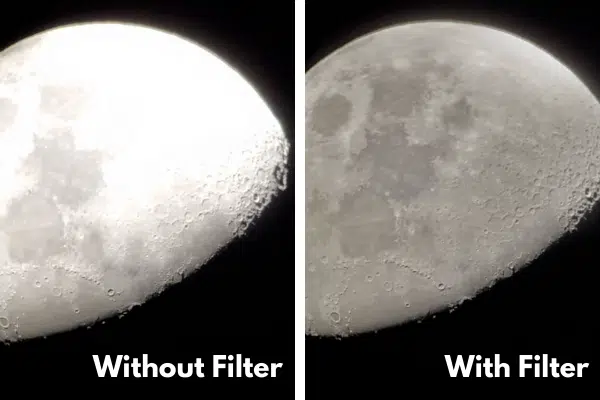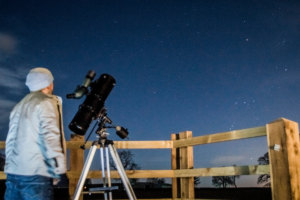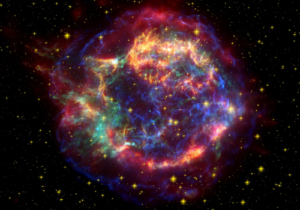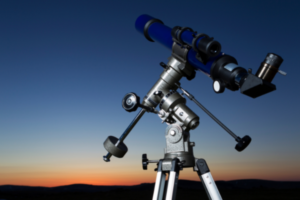What Does A Moon Filter Do? Do You Need One For A Telescope?
Disclosure: This post contains affiliate links and I may earn a small commission (at no extra cost to you) if you click through and make a purchase. Thanks in advance – I really appreciate it!
I remember the first time I looked at the full moon through my small telescope, it looked so much brighter than I had expected. I wasn’t really sure if that’s a good thing because I knew there were so many surface details that I wasn’t able to see properly because of the harsh brightness.
That is when I was first introduced to the moon filters.
Key Takeaways:
What does a moon filter do?
Moon filter is an accessory that screws into the bottom of the telescope’s eyepiece. A moon filter partially cuts down the Moon’s bright glare that is being captured by the lens of your telescope, improving contrast and increasing the level of finer surface details that you can see.
So basically a moon filter will enhance your moon viewing experience and make it much more enjoyable and rewarding as you see more detail on the moon’s surface than you ever have before.
In this article, we’re going to take a look at what moon filters are and when you should use one with your telescope. Later in this article, I will also give you my top recommendations for the best moon filters for your telescope.
What is a Moon Filter & What does it do for a telescope?
Our Moon is the most popular object to observe with a telescope. It’s an obvious target that’s easy to locate and full of exciting geographical features to explore.
The Moon typically reflects about 12% of the sunlight that falls upon it. This is why if you look at a thickening gibbous moon through even a moderately-sized telescope, it can appear uncomfortably bright, especially to the dark-adapted eye.
This is where a moon filter comes in!
A moon filter reduces the bright glare of the moon, increases contrast through selective filtration, increases definition and resolution which ultimately helps you see Moon’s finer surface details.
Most moon filters are neutral density filters meaning they do not affect the color during viewing. This is because moonlight is mainly white.
There are colored filters for telescopes, but they are mostly used to view more colored objects in space, such as different stars and certain planets.
Another advantage of using a moon filter is that it helps in lessening eye fatigue that comes with looking at a bright object for too long.
A moon filter attaches to the bottom of the telescope’s eyepiece.
A moon filter is essentially like sunglasses for your telescope because it provides a more comfortable view and reduces eye fatigue.
Moon filters will cut down glare and bring out much more surface detail and give you better contrast and resolution.
How do you use a moon filter on a telescope?
Using a moon filter on a telescope is fairly simple. Almost all telescope eyepieces are threaded at the bottom and a moon filter screws onto that. All you need to know is whether you have a 2” or 1.25” eyepiece and make sure you get a moon filter of the same size.
Moon filters are quite useful for scopes of as little as 80mm aperture, and they are essential for 100mm scopes or larger.
Fortunately, moon filters are simpler than light-pollution filters or narrow-band filters, and they are much more affordable.
Also, like other types of astronomy filters, moon filters come in threaded cells of 1.25” and 2” sizes that easily attach to an eyepiece barrel or diagonal.
Is it safe to look at the moon without a moon filter?
It is completely safe to look at the moon without a moon filter. You do not need a filter to look at the Moon. It is safe for your eyes to observe it without one, even during a full moon when it’s at its brightest.
That being said, there are times when using a filter can improve your viewing experience and give you more detail in the image.
Moon filters are designed to cut down on that bright light, which in turn will increase contrast bringing out the finer details of the moon during a viewing.
How does a moon filter affect the viewing experience?
To better understand the difference in viewing experience with and without a moon filter, let’s compare the two images side by side.

The image shows how a moon filter cuts down the bright light of the moon, which in turn increases contrast bringing out the finer details of the moon.
Pay close attention to the picture above. If you look carefully, you’ll notice how many more craters appear in the image with the filter on, and how clearly the depth and size of these rocky formations can be seen.
Since the moon filter helps the image gain a lot more contrast, the shadows are more clearly defined.
Also, most details that are not seen in the first image because they were lost to the brightness can be seen and appreciated in the second image which was taken with the moon filter on.
Type of Moon Filters
There are two main types of moon filters:
- Fixed Transmission Filters
- Variable Moon Filters
Fixed transmission moon filters allow a specific fixed amount of light through the filter at any given time. This is usually denoted as a percentage of light that it is designed to let through.
For example, a 13% filter only lets through 13% of the light which hits the lens or mirror of your telescope; a 25% filter will let through 25% of the light.
Variable moon filters, on the other hand, can be adjusted to allow for different amounts of light to shine through depending on the state of the moon during viewing.
A variable moon filter consists of two pieces of polarised glass that change how much light comes through when turned relative to each other.
A variable moon filter is a great choice if you want to have views of the moon during its various phases because you can increase the amount of light when the moon is in its crescent phase and then decrease the light when it’s in its gibbous phase.
When should you use a moon filter with your telescope?
A moon filter is one of the least expensive accessories that you can buy for your telescope. So even if you don’t feel the need to use a moon filter, I can assure you that it will be value for your money if you do decide to buy one, even more so if you intend to use your telescope mainly to look at the moon.
I have reviewed a few moon filters in the next section of this article, don’t forget to have a look at them and see which one fits your needs.
Here are a few situations that I can think of where it might be a good idea for you to have a moon filter in your arsenal.
1. If you have a telescope with an aperture size of 4” or more.
With smaller entry-level telescopes of aperture size from 3”- 4”, getting a moon filter won’t make much sense as they don’t collect that much light, to begin with.
On the other hand, telescopes with an aperture size of 4” or 100mm and above tend to collect a lot more light, and looking at the moon through such telescopes without a moon filter can be an unpleasant experience.
Not only will you miss out on observing many of the moon’s finer surface details, but your eyes may get fatigued too because of the harsh brightness of the moon.
2. If you intend to start your viewing session by looking at the moon first.
Most observers either don’t look at the moon when it’s full or leave it till the end of the observing session so that its night vision destroying brightness is of little consequence to trying to see faint fuzzies, as they have already seen them.
If you look at the moon at the beginning of your session before looking at the much fainter sky objects, the brightness of the Moon will definitely reduce your night vision temporarily because your eyes have to adapt to it.
So for the objects you try to observe afterward, your vision might take some time to adapt and you might not be able to distinguish as much detail in them.
3. If you want to see the moon’s finer surface details.
If you want to see the moon in all its glory and want to appreciate the topography of the Moon, with all its details, and locate the important craters and mountains, then a filter is almost a necessity as it will help you get the required level of detail.
Using a moon filter is useful, not just when it comes to helping you better see the moon’s details but also to make your viewing more comfortable – the moon is bright and therefore can be painful to look at sometimes.
Conclusion
So we have learned that a moon filter is a telescope accessory that is threaded on the eyepiece of your telescope, which makes you capable of viewing the moon in more detail.
Moon filters are of two types – fixed transmission and variable transmission moon filters, and they come in two common filter sizes i.e. 1.25” and 2”.
All telescopes have eyepieces and almost all eyepieces are threaded so that filters can fit on them.
Moon filters cut down glare and by doing that they enhance the details of the moon’s surface.
They also help in increasing contrast by decreasing brightness as they can transmit only some of the light hitting the eyepiece. Using a moon filter can change your entire moon-viewing experience.
Written by:

Kavya Joshi
My love affair with space began in a field in India at the age of 7, when I looked up at the Milky Way for the first time. Ever since, I have been attempting to cram in every fact about the Universe, I can find into my head.
ABOUT US
We are a team of active amateur astronomers, here to help you with all your astronomy and science related needs – this is anything, from reviewing the latest telescopes to be released to talking about gravity and neurons. The Big Bang Optics was started because of our love for astronomy and to help others like us find the best telescope and accessories.
LEGAL DISCLAIMER
The Big Bang Optics is a participant in the Amazon Services LLC Associates Program, an affiliate advertising program designed to provide a means for sites to earn advertising fees by advertising and linking to Amazon.com. The Big Bang Optics also participates in affiliate programs with Clickbank and other sites. The Big Bang Optics is compensated for referring traffic and business to these companies.




